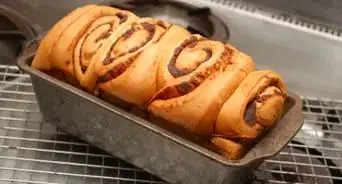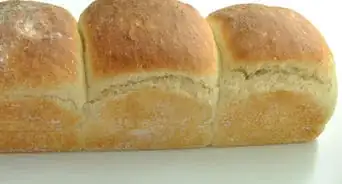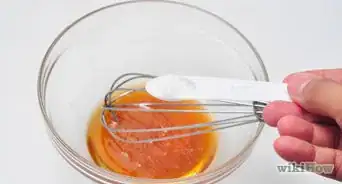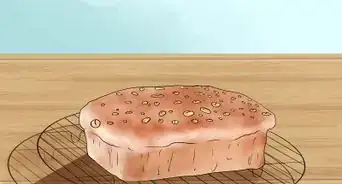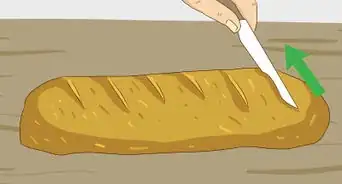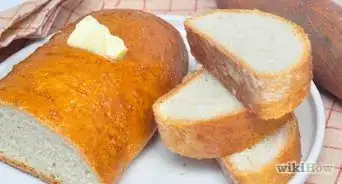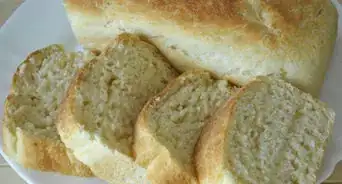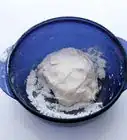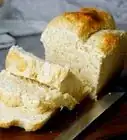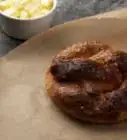This article was co-authored by Bill Holdenstern. Bill Holdenstern is a Baker and the Co-Owner of East Bay Pie Co. in San Francisco, California. With over 10 years of experience in the food industry, he specializes in making pot pies filled with flavors from around the world. Bill trained with chefs in multiple restaurants and studied business at Bunker Hill Community College. East Bay Pie Co has been profiled in The Manual, Purple List, and Nosh.
This article has been viewed 135,863 times.
To the inexperienced baker, "bread flour" and "all-purpose flour" may at first seem to be the same thing. In fact, bread flour is a special type of flour made from hard, high-protein wheat. This gives it a high gluten content and a "stronger," denser feel once it's baked. While bread flour isn't common in all kitchens, it's easy to make substitutes from the flour you do have lying around.
Steps
From All-Purpose Flour
-
1Buy or order vital wheat gluten. For this recipe, you'll need only two ingredients: all-purpose flour and vital wheat gluten. All-purpose flour can be purchased at nearly any grocery store. However, you may need to make a trip to a health food store or a baking supply store to find vital wheat gluten.[1]
- Alternatively, if you can stand to wait, vital wheat gluten is easily available for order online. Either way, it is not especially expensive — a small bag should cost less than $10.[2]
- You won't need more than a few teaspoons of vital wheat gluten for most bread recipes.
-
2Measure out the all-purpose flour for your recipe. Look at the recipe to see how much bread flour is required. Measure out this much all-purpose flour instead. Pour this flour into a mixing bowl separate from the other ingredients.Advertisement
-
3Add one teaspoon vital wheat gluten per cup of flour. This converts all-purpose flour to a form that can be used just like bread flour. This ratio scales proportionally.
- For instance, if your recipe calls for 2 1/2 cups of bread flour, you would add 2 1/2 teaspoons vital wheat gluten to 2 1/2 cups of all-purpose flour.
-
4Add a small amount of whole wheat flour. This step isn't essential, but a little wheat flour works well as a binding agent and gives the bread a subtle "nutty" flavor. Add no more than 1/2 teaspoon per cup of all-purpose flour so as not to affect the total volume of your dry ingredients.[3]
-
5Mix well. Sift the ingredients above together in the bowl. Once they are well incorporated, you will be left with a substance you can use in place of bread flour.
- The gluten in the new flour substitute will give the final product a denser, "stronger" bread than you would have otherwise. Don't be alarmed if your bread turns out with a slightly different texture than it had before.
From Wholewheat Flour
-
1Measure out wholewheat flour for your recipe. The basic process for converting wholewheat flour to bread flour is basically the same as above. However, a few qualities of wholewheat flour make some minor differences necessary. To start, add the wheat flour to a mixing bowl.
- Again, this is a one-to-one substitution for the bread flour in your recipe. If your recipe calls for three cups of bread flour, start with three cups of wholewheat flour (and so on).
-
2Add two teaspoons of vital wheat gluten per cup flour. Wholewheat flour contains a substance called bran which weakens the effects of gluten. This means that it's necessary to add more gluten artificially than you would with all-purpose flour.[4]
- This scales proportionally in the same way as in the section above. For instance, if you have three cups of wholewheat flour, you would add six teaspoons of vital wheat gluten.
-
3Mix well. Sift the ingredients together in the mixing bowl. When they are well combined, the substance you have in the bowl will substitute well for bread flour. However, for the best possible results, a few more precautions are necessary. See the next steps.
-
4Add extra water to the wet ingredients. The bran and protein content of wholewheat flour tend to make it slightly more absorbent than normal flour. To compensate, add a little extra to the wet ingredients you're using for your bread. About two and a half tablespoons of water per cup of wholewheat flour should be plenty.[5]
- To be clear, you'll want to add this water to the bowl where you're mixing the eggs, oil, milk, and so on. Don't add it directly to the flour or it will incorporate unevenly.
-
5Let the bread rise less than normal. When making bread, normally, you allow the dough to rise to about double its normal size.[6] However, with wholewheat flour, you'll only want to allow it to rise to about 1 1/2 times its normal size. This is because wholewheat flour tends to make dough a little less flexible. If you let the dough rise all the way, it won't be able to support its full size and will "deflate" somewhat during baking.[7]
Community Q&A
-
QuestionI have an all purpose gluten free flour. How do I make it into bread flour for my bread maker? It already has xanthum gum.
 Community AnswerAn all purpose flour, gluten free or otherwise, is just that, *all* purpose. Bread flours have a higher protein content which provides better gluten formation. Psyllium husk is an option, but you should be fine with what you have.
Community AnswerAn all purpose flour, gluten free or otherwise, is just that, *all* purpose. Bread flours have a higher protein content which provides better gluten formation. Psyllium husk is an option, but you should be fine with what you have. -
QuestionI don’t have vital wheat to make bread flour, what can I do?
 Why Don't We is LittCommunity AnswerYou can just use regular white flour to make the bread. I have a bread machine and my recipes call for bread flour (which I don't have), so I've learned that substituting regular white flour for wheat flour works best.
Why Don't We is LittCommunity AnswerYou can just use regular white flour to make the bread. I have a bread machine and my recipes call for bread flour (which I don't have), so I've learned that substituting regular white flour for wheat flour works best.
Warnings
- If you plan on using the bread flour to bake cookies, know that it might make them chewy, because there’s more gluten in bread flour than in AP flour.⧼thumbs_response⧽
References
- ↑ http://happyherbivore.com/2012/01/what-vital-wheat-gluten/
- ↑ http://www1.netrition.com/bobs_vital_wheat_gluten_flour.html
- ↑ http://www.food.com/recipe/homemade-bread-flour-substitute-416294
- ↑ http://www.epicurious.com/archive/howtocook/primers/breadingredients
- ↑ http://www.epicurious.com/archive/howtocook/primers/breadingredients
- ↑ http://www.bhg.com/recipes/how-to/bake/how-to-make-yeast-bread/
- ↑ http://www.epicurious.com/archive/howtocook/primers/breadingredients
- ↑ http://whatscookingamerica.net/Bread/FlourTypes.htm
About This Article
To make your own bread flour, start by measuring out all-purpose flour according to your recipe. Next, add 1 teaspoon of vital wheat gluten for every 1 cup of flour to give the bread a firmer texture. For example, if your recipe calls for 2½ cups of flour, you would use 2½ teaspoons of vital wheat gluten. You can also add ½ teaspoon of whole wheat flour for every 1 cup of flour if you want your bread to have a subtle, nutty flavor. Then, sift the ingredients together into a bowl and use the flour mixture to bake your bread. To learn more ways to make bread flour, including how to make bread flour from whole-wheat, scroll down.




